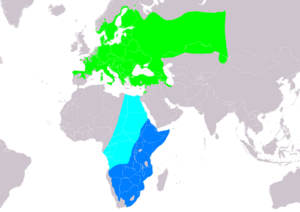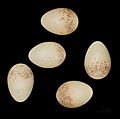Red-backed shrike facts for kids
The red-backed shrike (Lanius collurio) is a cool bird that eats meat! It's part of the shrike family. These birds live and breed across Western Europe all the way to central Russia. When winter comes, they fly south to warmer places in eastern and southern Africa.
Quick facts for kids Red-backed shrike |
|
|---|---|
 |
|
| Adult male | |
| Conservation status | |
| Scientific classification | |
| Genus: |
Lanius
|
| Species: |
collurio
|
 |
|
| Range of L. collurio Breeding Passage Non-breeding | |
Contents
Understanding the Red-backed Shrike's Name
The red-backed shrike was first officially described by a Swedish scientist named Carl Linnaeus in 1758. He gave it the scientific name Lanius collurio.
The name Lanius comes from a Latin word meaning "butcher." This is why some shrikes are also called "butcher birds." They got this nickname because of how they hunt and store their food.
The second part of its name, collurio, comes from an Ancient Greek word for a bird that Aristotle wrote about. The English word "shrike" comes from an old word meaning "shriek" or "screech," which describes the bird's loud call.
What Does the Red-backed Shrike Look Like?
This bird is about 16–18 cm-long (6.3–7.1 in) long. It's a migratory bird, meaning it travels long distances between its breeding and wintering grounds.
Red-backed shrikes are carnivores! They eat large insects, small birds, frogs, rodents, and even lizards. Like other shrikes, they hunt from high spots. They are famous for sticking their prey onto thorns or barbed wire. This acts like a "larder" or pantry, storing food for later. This unique habit is why they are called "butcher birds."
Male, Female, and Young Shrikes
The male red-backed shrike has a reddish-brown back. Its head is grey, and it has a cool black stripe across its eye, like a mask. Its belly is a light pink color. Its tail has a black and white pattern, similar to a wheatear bird.
Female and young shrikes look a bit different. Their upper parts are brown and have wavy patterns. Their underparts are a yellowish-brown color and also have these wavy markings.
Where Do Red-backed Shrikes Live?
These birds breed in most parts of Europe and western Asia. When winter arrives, they fly all the way to tropical Africa to stay warm.
Globally, the red-backed shrike is listed as a "least concern" (LC) species. This means that, overall, there are enough of them in the world. However, in some specific areas, their numbers have dropped a lot. So, in those places, they might be less common.
Red-backed Shrikes in Great Britain
The red-backed shrike used to be a common visitor to Great Britain. But their numbers dropped sharply during the 1900s. Now, it's considered a 'Red List' species in the UK, meaning it's in danger there.
For a while, their last main home was in Breckland. By 1988, only one pair was left, and they successfully raised young. The next year, no nests were found in the UK at all.
However, since then, some breeding has happened now and then, mostly in Scotland and Wales. In 2010, the RSPB (Royal Society for the Protection of Birds) shared exciting news: a pair had raised chicks in Dartmoor, England! This was the first time since 1970 that they had bred there.
In 2011, two pairs nested in the same area and had seven young birds. There was another attempt in 2012, but it didn't work out, maybe because of bad weather. In 2013, breeding was confirmed again in Devon, with two young birds. This return to south-western England was a surprise! Some people thought a warmer climate might be helping them come back. Since then, breeding has been confirmed only twice, both times in Shetland, in 2015 and 2020.
Gallery







